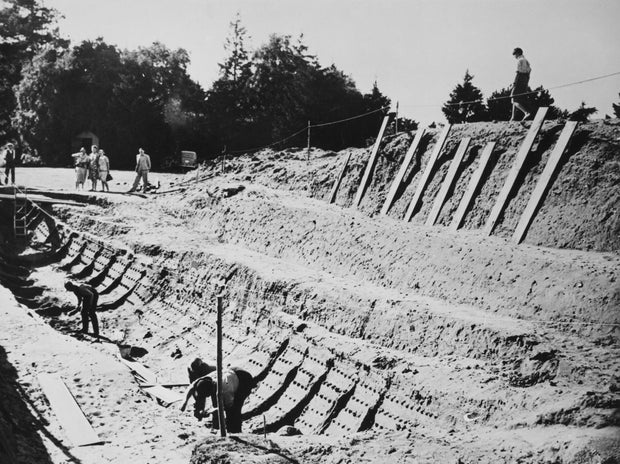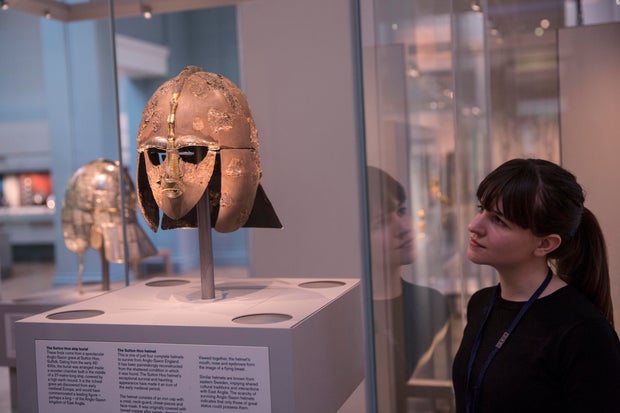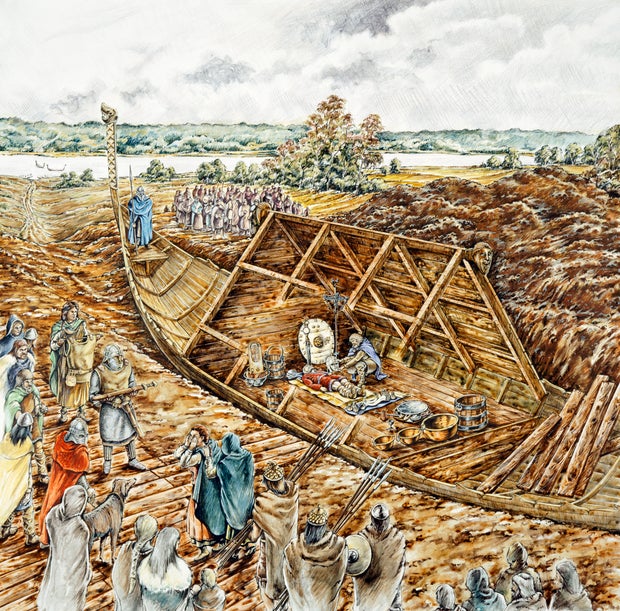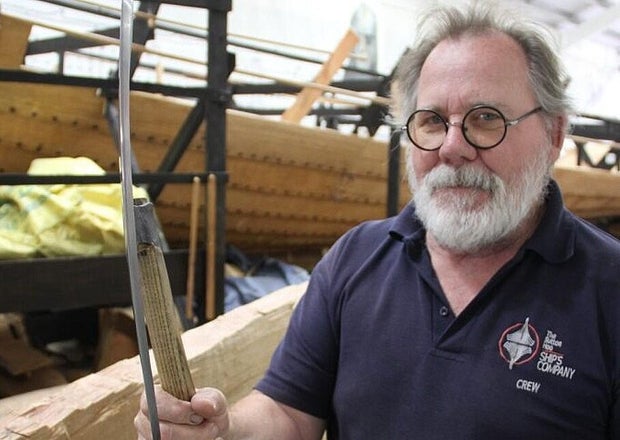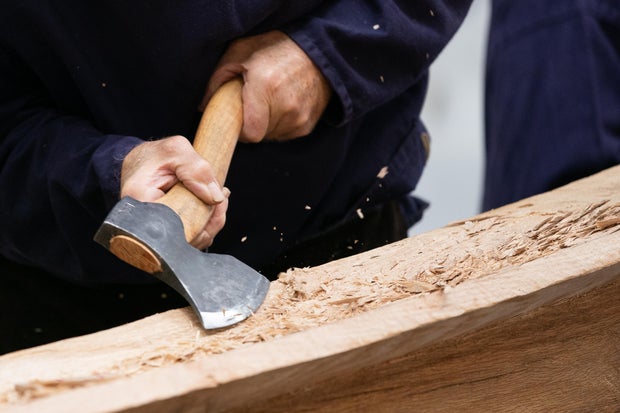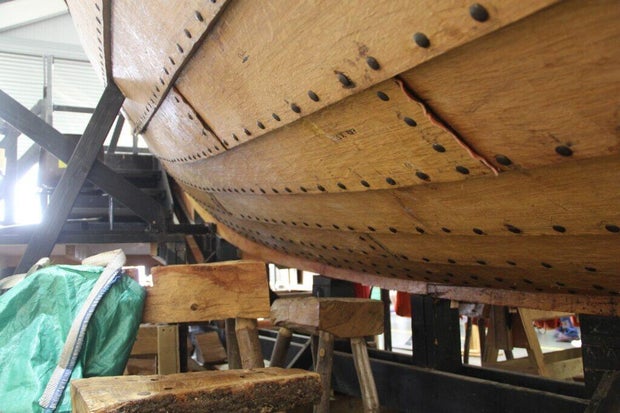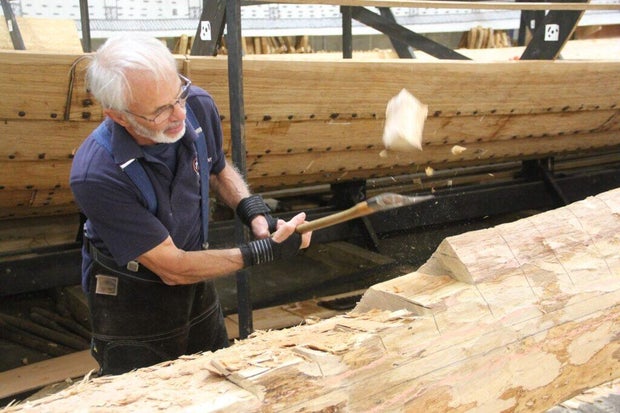Woodbridge, England — In a far-flung corner of southeast England, in a boatshed on the River Debden, a former U.S. Navy submariner whose career saw him serve on some of the most advanced nuclear-powered vessels of the 20th century has embarked on a mission into the past. David “Mac” MacDonald is one of 180 volunteers building a precise replica of a ship that set sail under the command of a king almost one-and-a-half millennia ago.
They’re working with The Sutton Hoo Ship’s Company in the small town of Woodbridge, and their mission is to build a historically accurate reproduction of the wooden longship famously discovered on the site, which is believed to have been the final resting place of a 7th-century Anglo-Saxon king.
Topical Press Agency/Hulton Archive/Getty
The remnants of the original ship were discovered buried at Sutton Hoo almost a century ago, just across the river from the reconstruction site.
Amid the skeleton of the old ship there was a wealth of Anglo-Saxon artifacts, which, along with the underdog story of its discovery, have brought the site international fame.
The treasure trove included the “Sutton Hoo Helmet,” the most iconic remnant of Anglo-Saxon England.
Oli Scarff/Getty
The old ship was in poor condition when amateur archaeologist Basil Brown discovered it — little more than an imprint in the sand, measuring about 90 feet in length.
Due to the relative lack of knowledge about this period in English history, the find was dubbed “one of the most important archaeological discoveries of all time” by a curator at the British Museum.
There’s an ongoing debate as to who exactly was buried in the longship, but the most widely accepted theory is that King Raedwald of East Anglia was entombed in the vessel. He was among the first English kings to convert to Christianity, and is of no relation to the current royal family.
English Heritage/Heritage Images/Getty/artist Peter Dunn
The boathouse in which the ship is being reconstructed from scratch draws over 9,000 visitors every month, along with many volunteers. MacDonald grew up in New England and then lived in North Carolina for 30 years, but he moved to the U.K. seven years ago.
He built bespoke furniture and is a trained violin maker, but he put all that aside for a set of Anglo-Saxon axes after one of his wife’s friends mentioned the project. Now he’s part of the longship family, where he says he has “been made most welcome.”
Archie Clarke/CBS News
MacDonald said he and his fellow shipbuilders can already envision the longship as it takes shape before them, telling CBS News: “We’re just carving away all the wood that doesn’t look like a boat.”
But the project is far from simple. It aims to recreate the longship using the same methods and tools that would have been used by the Anglo-Saxons — axes, mallets and clamps, all made from designs over 1,400 years old — and to make it seaworthy.
Joe Giddens/PA Images/Getty
The team started construction in 2019, with hopes of completing the project by early 2027.
Master Shipwright Laurie Walker described to CBS News the huge amount of time required to manufacture each individual part of the ship. The hull will be made of about 90 wood planks, each one requiring between 30-40 hours of work to craft. Those planks will be held together by about 3,800 wrought iron nails, all locally made.
The wood used for the ship’s handcrafted parts is as labor-intensive to find as it is to fashion into the needed components. Project horticulturist Andy Spencer said every tree used as source material must be selected based on its unique length, shape and lack of imperfections.
Archie Clarke/CBS News
Spencer said the keel of the ship, for instance, required an almost perfectly straight, 43-foot oak tree, which required an arduous search process — one that must be repeated for virtually every primary component.
Spencer is also head of the project’s replanting program, which aims to replant roughly 20 oak trees for every one that is cut down. The new trees are being planted close to where the longship is under construction, in the newly-annointed “Saxon Ship Wood.”
Another challenge for the team is the lack of historical plans for the original Sutton Hoo ship, which was built, “smack bang in the middle of a period about which we know absolutely nothing,” according to project board chairman Sean McMillan.
That’s not because the Anglo-Saxons didn’t record their work, but because Viking raids in the subsequent centuries saw many monasteries along England’s east coast — where historical records would have been kept — plundered and destroyed.
Archie Clarke/CBS News
As such, details of the Sutton Hoo burial ship, which, according to McMillan, “in its day would have been the equivalent of an aircraft carrier,” are non-exsistent.
“During the build there’s a lot of questions coming up of, ‘Well, how would they have done this?’ Well, we don’t know, because there’s no evidence of it,” said McMillan.
So they have to work with what they’ve got – the remains of the hulking vessel pulled from the Suffolk county mud.
